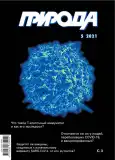The Bodies of the Zodiacal Light: Origin, Evolution, Fallout to Earth
- Authors: Byalko A.V1
-
Affiliations:
- Landau Institute for Theoretical Physics, RAS
- Issue: No 5 (2021)
- Pages: 25-33
- Section: Articles
- URL: https://journals.eco-vector.com/0032-874X/article/view/631053
- DOI: https://doi.org/10.7868/S0032874X21050045
- ID: 631053
Cite item
Abstract
This work continues a series of articles that consider the fragments of the Giant Impact, which resulted in the Moon formation. We believe that one of the
About the authors
A. V Byalko
Landau Institute for Theoretical Physics, RAS
Email: alex@byalko.ru
Moscow, Russia
References
- Jorgensen J.L., Benn M., Connerney J.E.P. et al. Distribution of interplanetary dust detected by the Juno spacecraft and its contribution to the zodiacal light. JGR Planets. 2021; 126(3): e2020JE006509. doi: 10.1029/2020JE006509.
- Divari N.B. Zodiacal light. Sov. Phys. Usp. 1965; 7: 681–695. doi: 10.1070/PU1965v007n05ABEH003657.
- Byalko A.V., Kuzmin M.I. Fragments of the Moon formation: geophysical consequences of the Giant Impact. J. Exp. Theor. Phys. 2019; 129: 511–520. doi: 10.1134/S1063776119100182.
- Hollabaugh M., Everhart E. Earth horseshoe orbits. Astrophysical Letters. 1973; 15: 1–5.
- Ballouz R.-L., Walsh K.J., Barnouin O.S. et al. Bennu’s near-Earth lifetime of 1.75 million years inferred from craters on its boulders. Nature. 2020; 587: 205–210. doi: 10.1038/s41586-020-2846-z.
- Quinn T.R., Tremaine S., Duncan M. A three million year integration of the Earth’s orbit. Astronomical Journal. 1991; 101: 2287–2305.
- Laskar J., Joutel F., Boudin F. Orbital, precessional, and insolation quantities for the Earth from –20 Myr to +10 Myr. Astronomy and Astrophysics. 1993; 270: 522–533.
- Lüthi D., Le Floch M., Bereiter B. et al. High-resolution carbon dioxide concentration record 650,000–800,000 years before present. Nature. 2008; 453: 379–382. doi: 10.1038/nature06949.
- Petit J. R., Jouzel J., Raynaud D. et al. Climate and atmospheric history of the past 420,000 years from the Vostok ice core, Antarctica. Nature. 1999; 399: 429–436. doi: 10.1038/20859.
- Lambert F., Delmonte B., Petit J.R. et al. Dust-climate couplings over the past 800,000 years from the EPICA Dome C ice core. Nature. 2008; 452: 616–619. doi: 10.1038/nature06763.
- Lanci L., Delmonte B., Salvatore M.C., Baroni C. Insight into provenance and variability of atmospheric dust in Antarctic ice cores during the late Pleistocene from magnetic measurements. Frontiers in Earth Science. 2020; 8: 258. doi: 10.3389/feart.2020.00258.
- Гурвич Е.Г. Металлоносные осадки Мирового океана. М., 1998.
- D’Hondt S., Inagaki F., Zarikian C.A. et al. Proceedings of the Integrated Ocean Drilling Program. Volume 329 Expedition Reports. 2010. doi: 10.2204/iodp.sp.329.2010.
- Misawa K., Kohno M., Tomiyama T. et al. Two extraterrestrial dust horizons found in the Dome Fuji ice core, East Antarctica. Earth Planetary Science Letters. 2010; 289: 287–297. doi: 10.1016/j.epsl.2009.11.016.
- Van Ginneken M., Folco L., Perchiazzi N. et al. Meteoritic ablation debris from the Transantarctic Mountains: Evidence for a Tunguska-like impact over Antarctica ca. 480 ka ago. Earth Planetary Science Letters. 2010; 293: 104–113. doi: 10.1016/j.epsl.2010.02.028.
- Van Ginneken M., Goderis S., Artemieva N. et al. A large meteoritic event over Antarctica ca. 430 ka ago inferred from chondritic spherules from the Sor Rondane Mountains. Science Advances. 2021; 7(14): 1008–1019. doi: 10.1126/sciadv.abc1008.
- Martin J.H. Glacial-interglacial CO2 change: The Iron Hypothesis. Paleoceanography and Paleoclimatology. 1990; 5(1): 1–13. doi: 10.1029/PA005i001p00001.
- Reach W.T. Zodiacal emission. I. Dust near the Earth’s orbit. Astrophysical Journal. 1988; 335: 468–485.
- Reach W.T. Zodiacal Emission. II. Dust near ecliptic. Astrophysical Journal. 1991; 369: 529–543.
Supplementary files









